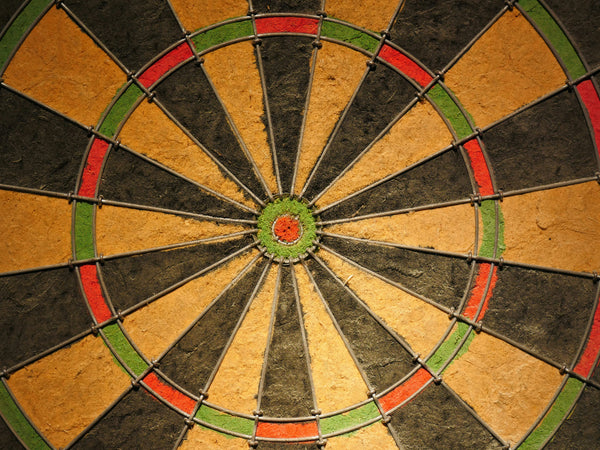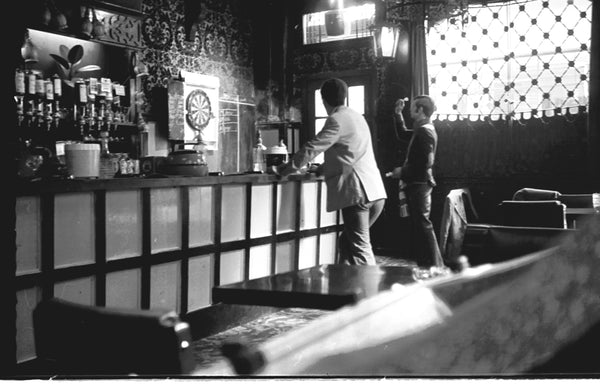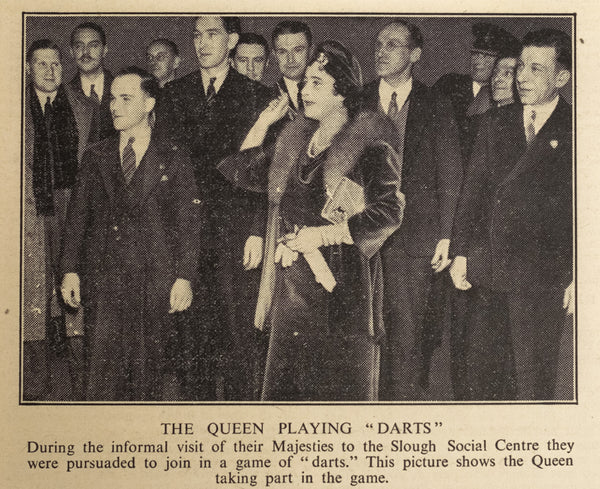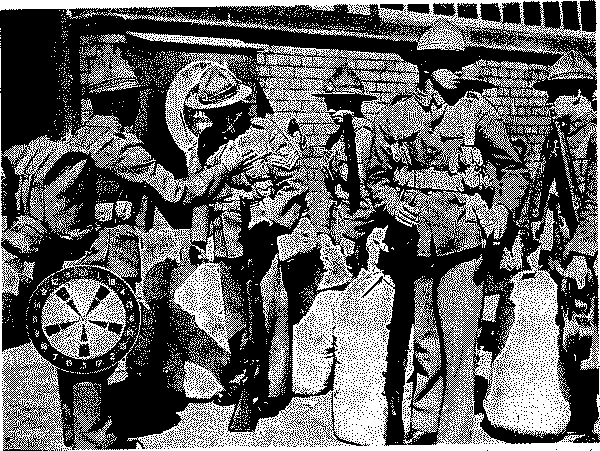A Brief History of Darts

The origins of darts dates back hundreds of years and has developed into the global sensation we know today. The present day sees the world’s best darts players competing in a professional tour and for millions of pounds in prize money. But to discover the history of darts you have to delve as far back as the 1300s and the medieval era!
This blog will look at who invented darts and where did darts originate, before exploring how it has developed from a pub game to the current day where the professionals play in front of thousands of fans in venues all across the world.
The Origins of the Game
The history of darts can be traced back to England in the medieval era of the 1300s. Historians have said that back then it was not darts as we know it today, but its earliest version was adopted by soldiers, and it was a game played as a military past time. Soldiers would compete against each other whilst sat in the trenches by throwing spearheads at wine casks that had been turned on the side. Back then darts was seen as a useful leisure activity for soldiers to help practice their aim. This early origin would progress to using tree trunks as the target to throw sharp objects at, with the rings on the cross-section of a tree trunk the inspiration behind the rings we see on dartboards today.
The modern game of darts actually stems back to France and sometime in the 19th century when they would play with fléchettes (meaning ‘small arrows’) which were made from wood, but also had a metal point and a flight made from turkey feathers. The fundamentals of darts, aiming and throwing at a board, has carried through to the game today, but the advances in materials and technology means players will now often use a set of tungsten darts to play with.
The English game of darts originates at the fairground, with the dartboard divided up into different numbered segments and to win a prize you had to reach a certain total score with your darts. This is believed to be where the idea of a dartboard being split into number sections came from, which is something that is still seen today with professional dartboards displaying the numbers 1-20 and players taking it in turns to aim for certain numbered segments on the board.
From these early beginnings of darts being a past time for soldiers and then a fairground game, it would quickly become a competition which has carried through to the present day. Darts has changed progressively over the years before becoming the game we know it as today, but history suggests the very start of darts can be dated as far back as more than 700 years ago.
Darts enters the Pubs of England

Playing darts in a pub in the City of London, 1974. Photo by Klaus D Peter via Wikicommons
The 19th century saw the spread of numerous versions of darts, but still not fully consolidated and organised together. During this time there was no standard rule set that had emerged yet, with the game still continuing to spread exponentially, nonetheless. England’s pubs began to include dartboards and games were soon devised, with many regions having their own design of board. For example, a London 5’s board was split into 12 sections, consisting of only 20, 15, 10 and 5 segments. A Yorkshire dartboard featured the segments 1-20, but with no trebles, and just singles and doubles.
However, the introduction of darts in pubs did face its challenges and in 1908, Jim Garside, the landlord of the Adelphi Inn, in Leeds, was taken to court for allowing darts to be played in his pub. At the time gambling or games of chance were not allowed in pubs, so Mr Garside had to prove in court that darts was not a game of chance but was in fact a game of skill. The landlord brought with him William ‘Big Foot’ Annakin, then considered one of the best darts players in the area, to throw at a dartboard and hit several targets in a row, with the court then declaring darts was a legal game of skill.
The darts pub scene continued to rise in its popularity in the lead up to the First World War, with pub leagues being introduced. The National Darts Association (NDA) was formed in 1925 to help put together formal rules for the game and remained in charge until the start of the Second World War. In the 1930s, dart was banned in some parts of the UK, including in Liverpool, Glasgow and Huddersfield for reasons such as on health grounds, or it encouraged drunkenness, or it would encourage young people to enter pubs. These bans would finally be lifted after the Second World War.
Watch the video below which shows men playing darts in a pub and trophies being presented by the NDA during the 1930s.
Who Invented Darts?
Whilst he did not exactly invent the game of darts, Brian Gamlin is generally credited as the inventor of the numbering system used on modern dartboards today. Mr Gamlin, a man from Bury, in Lancashire, came up with the 1-20 number sequence in the late 1880s that is still displayed on dartboards all these years later. The invention of this numbering system is considered to be one of the most impactful changes, helping darts to gain even more popularity and eventual recognition as a sport.

The numbers 1-20 are displayed on a dartboard (see right) in an order which is not random, but intentional to provide the game with depth and a degree of fairness. The 20 segment sits at the top of the dartboard, with 5 on the left and 1 on the right, with the aim of making the most rewarding targets more difficult to hit, therefore rewarding players who are more accurate and punishing players who are less accurate with their darts. The 19 segment is positioned on the other half of the board, which helps to reduce the possibility of ‘lucky shots’ and lowers the element of chance in the game.
The dartboards used today, that are made of bristle, dates back to the 1930s. Edward Leggatt first created an odourless clay which he used to construct dartboards in the early 1920s, with boards previously made of wood or coiled paper, cork and gum. The bristle dartboard is crafted from Sisal fibres and has proven to be efficient and longer lasting. In the 1970s, the bristle board eventually became the go-to option for major competitions and has remained that way for more than 50 years.
A typical dartboard nowadays is 47.08cm in diameter and divided into 20 sections, with the bullseye and outer bullseye in the centre. The segments are separated with metal wire, with the continued advances in technology resulting in thinner wires being used, which helps to eliminate the chance of a ‘bounce out’ when the dart hits the wire and falls out of the board.
Darts During the World Wars of the 20th Century
Company Sergeant-Major Tahuriotangi, of the Maori Contingent of the Second Echelon, took his own darts board to England, and had it attached to his belt when the New Zealand troops landed at an English port recently. (Evening Post, 05 August 1940). Alexander Turnbull Library, Wellington, New Zealand. Credit: Sport and General Photo (records/17746070)
Following the growth of the darts pub scene in the 1910s and 1920s, the News of the World Individual Darts Championship was organised by the NDA in 1927 – a tournament which would leave a long-lasting legacy in the darts history books. The first staging of the News of the World event featured 1,010 participants and covered only the Metropolitan Area around London, before the tournament branched out to include most of England. The 1938/39 edition boasted an incredible field of more than 280,000 players.
The Second World War affected all sports, including darts, with competitions being either cancelled or suspended. The News of the World event was not held again until 1947, but in the meantime the newspaper kept up the game’s high profile by setting up a ‘team of darts champions’. The team included famous English players Jim Pike and John Ross and would take on all-comers in challenge matches, which would raise money for the Red Cross. By the end of the war, more than £200,000 was raised through these matches, a figure eclipsing every other sport.
Darts would also play an important role in maintaining the morale of British people at home and abroad. Many troops took the game up as a pastime, thus emulating the origins of darts hundreds of years before during the Medieval Era of the 1300s. Darts would be issued out in sports packs for the navy, army and air force during the latter part of the war.
During this period, British troops would share the game of darts with many of their allies from America, Australia and New Zealand. After being introduced to darts, these servicemen and women would then take darts back home with them at the end of the war and help the game spread globally as more and more people discovered it for the first time.
How the game evolved post-WW2
The game of darts evolved following the Second World War when the National Darts Association of Great Britain (NDAGB) was set up to help organise leagues at local and national levels. At this time there was minimal media coverage of darts, aside from the annual News Of The World championship which continued to attract a large number of entries across the country.
The ‘golden era’ of darts on television would follow in the 1970s and 1980s, with the British Darts Organisation (BDO) established in 1973 and taking over the governance of the sport. Led by Olly Croft, the BDO brought in sponsors and television coverage and helped turn the game into one that attracted international attention.
The inaugural BDO World Darts Championship was held in 1978, at the Heart of the Midlands Club, in Nottingham. Leighton Rees beat John Lowe 11-7 in legs to become the first champion and pocketed £3,000, with Lowe collecting £1,700 for his run to the final. This period saw several players become household names, including the five-time world champion Eric Bristow, Alan Evans, Jocky Wilson and Cliff Lazarenko.
In 1983, more than eight million television viewers watched Keith Deller beat Bristow in the World Championship final. The following year saw history made as Lowe threw the perfect nine-dart leg – the first ever in a televised darts tournament. Watch the video of Lowe’s nine-dart finish below.
Darts as we know it today
Darts at the top level underwent monumental changes in the early 1990s, with 15 of the top professional players breaking away from the BDO to form their own organisation. The World Darts Council (WDC) was created with the goal to promote the professional game and secure more television coverage. Following the boom period of the 1970s and 1980s, the sport was in decline by 1992 with only one tournament on TV (the BDO World Darts Championship), and change was needed to take the professional side of darts to the next level.
The 15 players who initially broke away from the BDO included Phil Taylor, Dennis Priestley, Eric Bristow, John Lowe and Jocky Wilson, many of the game’s household names. The BDO’s response was to ban all of these players from playing in county darts, super leagues and all BDO tournaments. The ban would only be lifted if a player returned to the BDO, with Mike Gregory and Chris Johns both pledging their loyalty back with the BDO, whilst the other 13 players stuck with the WDC.
The two organisations would later go to court, which was won by the WDC, and the Tomlin Order was put in place, meaning players could play in any tournaments they wanted. The only exception to this was that players could only compete in one of the two World Championships, as by this time the WDC was staging their own version of a World Championship.
The WDC was rebranded as the Professional Darts Corporation (PDC), which is now viewed as the world leader in darts, running a multi-million pound tour of professional events for players to compete in each year. The PDC also has extensive live coverage of its tournaments across many broadcast partners, including Sky Sports and ITV, and the top stars in the game are now seen on our screens more than ever before.
The ladies game has also undergone many changes over the years, with the BDO introducing a Women’s World Championship in 2001. Since 2022, this event is now held by the World Darts Federation (WDF), whilst the PDC run a Women’s Series – a collection of tournaments each year with spots in the Grand Slam of Darts and PDC World Darts Championship up for grabs for the best performers over the season.
Read our 'Female Darts Players: Redefining The World Of Darts' blog for a closer look at the key women that have changed the darting landscape, and find out more about the Queen Elizabeth I (pictured below) playing a game of darts against the King during the 1930s. Check out our Ladies Darts range for the signature darts and accessories of many of the top female players in the game today.

What does the future of darts look like?
The future looks incredibly bright for darts. More young people have been introduced to the game off the back of Luke Littler’s incredible run at the 2024 PDC World Darts Championship. Then aged just 16-years-old, ‘The Nuke’ became the youngest finalist in the history of the competition and helped attract record viewing figures and unprecedented media attention to the game.
Darts is an accessible sport to many people and will continue to thrive as it can be played as a leisure activity, or for more serious players you can aim to play professionally and join the likes of Littler and the 2024 world champion Luke Humphries on the PDC tour. For many years there have been calls for darts to become an Olympic sport, which would take the sport to an even wider audience, but in the meantime the ‘Luke Littler effect’ is sure to keep this new-found excitement around the game going for many months and years to come.
We hope you have enjoyed exploring the brief history of darts in this blog and for the latest darts news check out the ‘Darts News’ section of our blog.

Luke Humphries (left) and Luke Littler embrace following their match at the 2024 PDC World Darts Championship. The final brought in record viewing figures for a darts match on Sky Sports. Picture: PDC

